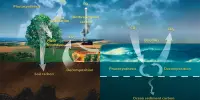Jet engine lubrication oils can produce ultrafine particles when they are atomized during the engine’s operation. These particles are smaller than 100 nanometers in diameter and can be inhaled into the lungs, which can have negative health effects. To minimize the production of ultrafine particles, jet engine manufacturers have developed lubrication oils that have a lower volatility and produce fewer emissions during engine operation. Additionally, aircraft operators may use filtration systems to capture and remove ultrafine particles from the engine’s exhaust before it is released into the atmosphere.
According to recent measurements, Frankfurt International Airport is a major source of ultrafine particles, which can disperse over long distances throughout the city. Researchers have discovered that the ultrafine particles contain synthetic jet oils in part. The research team concluded that lubricant oil emissions must be reduced in addition to kerosene emissions in order to reduce the concentration of ultrafine particles and thus improve air quality.
Ultrafine particles form during combustion processes, such as the burning of wood or biomass, as well as in power and industrial plants. Large airports, in addition to road traffic, are a major source of these ultrafine particles, which are less than 100 millionths of a millimetre (100 nanometres) in size. Because they are so small, they can penetrate deep into the lower respiratory tract, overcome the air-blood barrier and, depending on their composition, cause inflammatory reactions in the tissue, for example. What’s more, ultrafine particles are suspected of being capable of triggering cardiovascular diseases.
When the oil vapour cools, the gaseous synthetic esters become supersaturated and form the nuclei for new particles, which can then grow rapidly to a size of around 10 nanometres. As our experiments show, these particles account for a significant portion of the ultrafine particles produced by aircraft engines.
Alexander Vogel
Since several years, the Hessian Agency for Nature Conservation, Environment and Geology (HLNUG) has been measuring the number and size of ultrafine particles at various air monitoring stations in the vicinity of Frankfurt International Airport, for example in the Frankfurt suburb of Schwanheim and in Raunheim. Last year, scientists led by Professor Alexander Vogel at Goethe University Frankfurt analysed the chemical composition of the ultrafine particles and came across a group of organic compounds which, according to their chemical fingerprints, originated from aircraft lubrication oils.
The research team has now corroborated this finding by means of further chemical measurements of the ultrafine particles: the particles originated to a significant degree from synthetic jet oils and were particularly prevalent in the smallest particle classes, i.e. particles 10 to 18 nanometres in size. Such lubrication oils can enter the exhaust plume of an aircraft’s engines, for example through vents where nanometre-sized oil droplets and gaseous oil vapours are not fully retained.

In laboratory experiments, the researchers also succeeded in reproducing the formation of ultrafine particles from lubrication oils. To this end, a common engine lubrication oil was first evaporated at around 300 °C in a hot gas stream, which simulated the exhaust plume of an aircraft engine, and subsequently cooled down. The number-size distribution of the freshly formed particles was then measured.
Alexander Vogel, Professor for Atmospheric Environmental Analytics at Goethe University Frankfurt’s Institute for Atmospheric and Environmental Sciences, explains: “When the oil vapour cools, the gaseous synthetic esters become supersaturated and form the nuclei for new particles, which can then grow rapidly to a size of around 10 nanometres. As our experiments show, these particles account for a significant portion of the ultrafine particles produced by aircraft engines.”
The previous assumption that ultrafine particles are primarily formed by sulphur and aromatic compounds in kerosene is clearly flawed. Reduced lubrication oil emissions from jet engines, according to our findings, have a significant potential for reducing ultrafine particles.”
The experiments show that the formation of ultrafine particles in jet engines is not limited to kerosene combustion. Potential mitigation strategies should take this into account. This means that using low-sulfur kerosene or switching to sustainable aviation fuel will not eliminate all ultrafine particle pollution.
The Federal State of Hesse will conduct a comprehensive scientific study on ultrafine particle pollution and its impact on health, which will begin in 2023. In this context, the current study’s findings can aid in the identification of airport-specific particles and the development of potential mitigation measures.
















